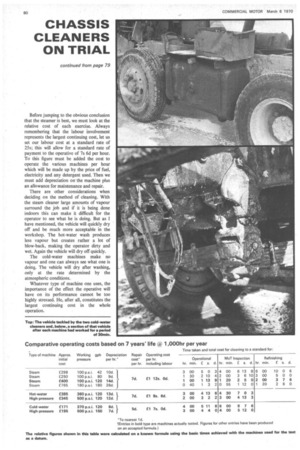CHASSIS CLEANERS ON TRIAL
Page 82

If you've noticed an error in this article please click here to report it so we can fix it.
continued from page 79
Before jumping to the obvious conclusion that the steamer is best, we must look at the relative cost of each exercise. Always remembering that the labour involvement represents the largest continuing cost, let us set our labour cost at a standard rate of 25s; this will allow for a standard rate of payment to the operative of 7s 6d per hour. To this figure must be added the cost to operate the various machines per hour which will be made up by the price of fuel, electricity and any detergent used. Then we must add depreciation on-the machine plus an allowance for maintenance and repair.
There are other considerations when deciding on the method of cleaning. With the steam cleaner large amounts of vapour surround the job and if it is being done indoors this can make it difficult for the operator to see what he is doing. But as I have mentioned, the vehicle will quickly dry off and be much more acceptable in the workshop. The hot-water wash produces less vapour but creates rather a lot of blow-back, making the operator dirty and wet. Again the vehicle will dry off quickly.
The cold-water machines make no vapour and one can always see what one is doing. The vehicle will dry after washing, only at the rate determined by the atmospheric conditions.
Whatever type of machine one uses, the importance of the effect the operative will have on its performance cannot be too highly stressed. He, after all, constitutes the largest continuing cost in the whole operation.




























































































































































